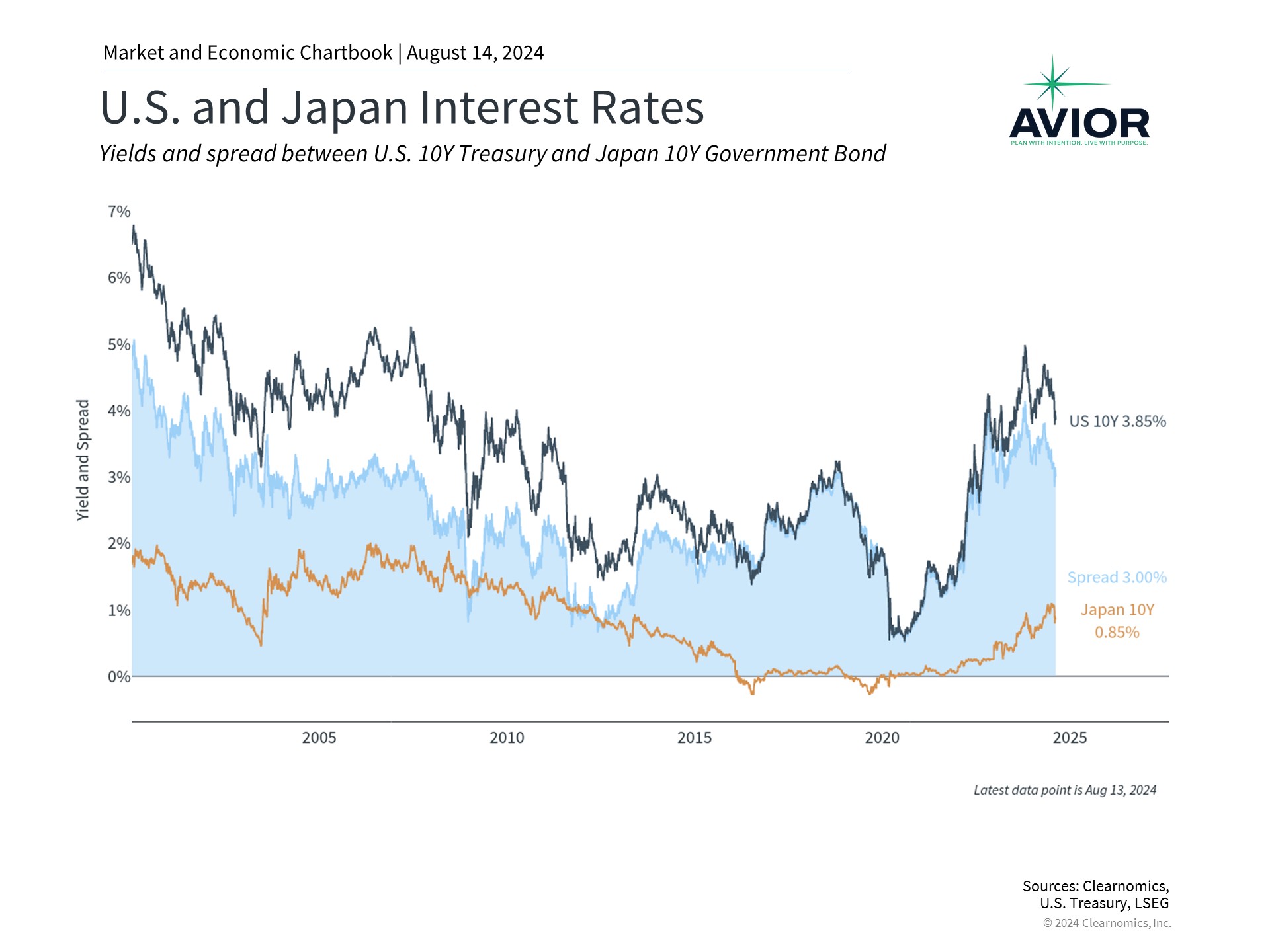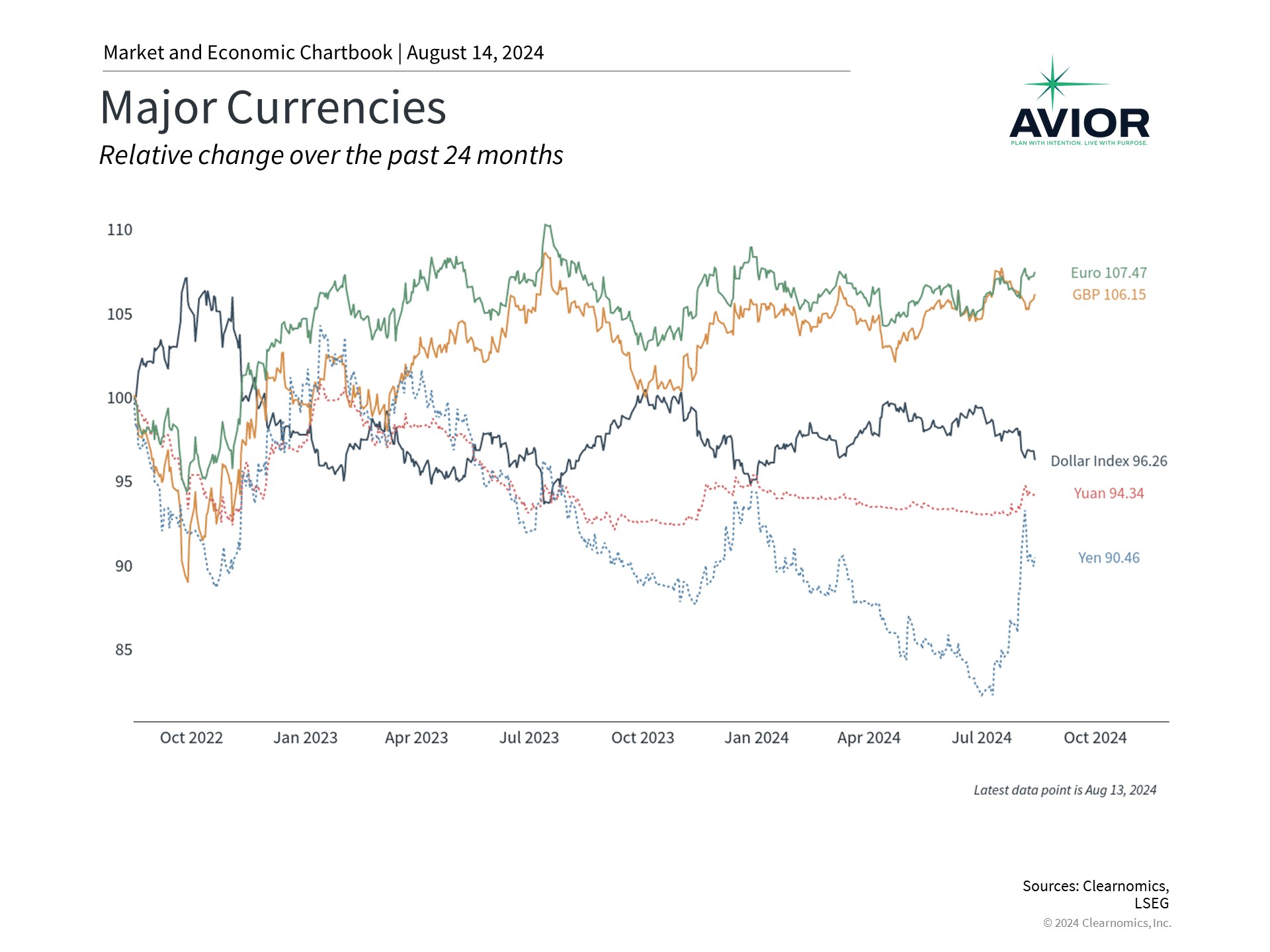How Carry Trades and Market Fragility Impact Investors
Financial markets have felt more fragile recently with investors concerned about the economy, the possibility that the Fed may be behind on cutting rates, and some disappointing tech earnings. Ironically, despite the market volatility last week, major indices were mostly unchanged from Monday to Friday. While they are down from their recent all-time highs, and there is heightened market uncertainty, the S&P 500, Nasdaq, and Dow are still up 13%, 12%, and 6% with dividends this year. This is a reminder that while market swings are never pleasant, looking past short-term volatility is the best way for investors to stay focused on their goals.
The unwinding of the Japanese carry trade

In addition to economic and fundamental factors, market technicals may have also worsened the recent pullback, with investors focused on the unwinding of the Japanese carry trade. Much has already been written on this topic in the financial news, but it is an important example of how technicals can impact markets in the short run even as fundamentals drive returns in the long run. What is a carry trade and why is it being blamed for global stock market declines?
While it may seem complex at first, the concept of a carry trade is actually quite easy to understand. A carry trade simply involves borrowing at lower interest rates and investing at higher interest rates, thereby earning the difference in yields. This also requires buying and selling currencies since investors will often utilize government bonds around the world. In general, carry trades are more attractive when there is a large difference in interest rates and when currencies are stable.
Borrowing using the Japanese yen for the carry trade has been popular for decades since Japan’s interest rates have been extremely low. Until recently, the Bank of Japan’s policy rate had been negative since 2016 and had not been higher than 0.1% since 2008. In fact, the highest it has been this century is 0.5%. There were many reasons for low rates in Japan including the risk of deflation, sluggish growth, and poor demographic trends. This period is sometimes referred to as Japan’s “lost decades.”
This all changed recently due to rising inflation and the Bank of Japan raising rates to 0.25%, all while the Fed is expected to cut rates. Not only does this decrease the interest rate differential between the U.S. and Japan, but the Japanese yen has also strengthened over the past month and jumped overnight when market volatility hit. These market moves work against the typical carry trade since the difference in rates shrinks and the borrowing currency becomes more expensive. Note that the way the yen is typically quoted – the number of Japanese yen per U.S. dollar – a higher number represents a weaker yen.
Recent volatility has been worsened by financial leverage

On its own, the reversal of one trade does not usually trigger widespread concern, especially on a global scale. However, since carry trades depend on borrowing, they can have an amplified effect. This concept, known as financial leverage, has worsened market crises throughout history including the 2008 global financial crisis, the 1997 Asian currency crisis and collapse of Long-Term Capital Management, and even the Crash of 1929.
As the economist Hyman Minsky explained, “the more stable things become and the longer things are stable, the more unstable they will be when the crisis hits.” In this case, the carry trade has a long history and is based on economic trends that have lasted for decades. The longer a trade works, the more willing investors are to steadily increase the size of their bets – just as a gambler does in a casino when they believe they are on a hot streak. Eventually, there is likely to be a “Minsky Moment” whereby the unwinding of the trade is worsened by this leverage. Naturally, investors avoid the trade for some time, before returning and beginning the cycle anew.
This concept is crucial for investors since it highlights the importance of monitoring financial stability and the potential risks associated with excessive optimism and risk-taking in financial markets. Most recently, this occurred in 2021 during the so-called “everything rally” following the pandemic. These periods are characterized by excessive optimism that is detached from market and economic fundamentals.
However, it’s also important to keep in mind that shocks to different parts of the market are not unusual, and not every potential source of fragility results in this level of volatility. Many economic cycles experience periods of expansion and contraction without triggering a crisis on the order of 2008 or 2020. Last year’s banking crisis is a recent example of a serious issue that eventually stabilized. So, while vigilance is necessary, it’s equally important for investors to maintain a balanced perspective, recognizing that markets have historically demonstrated the capacity to overcome challenges.
Market pullbacks are normal and expected

Major stock market indices are still below their recent highs and it’s always possible that investor unease could continue. The Nasdaq is still in correction territory, having fallen 10% from its peak, while the S&P 500 is only halfway to a correction. Still, history suggests that pullbacks and corrections are not only normal but can also be healthy as markets adjust to new economic, market, and company data. The accompanying chart shows that the typical correction involves a decline of 14% on average, which then recovers within four months. The key, however, is that the recovery can begin when investors least expect it.
So, while day-to-day swings can be unsettling for investors, it’s far more important to understand the longer-term trends. The unwinding of the Japanese carry trade may have resulted in shockwaves across global markets, but there are signs that the situation is stabilizing. Focusing on the business cycle, corporate earnings, and underlying market factors can help investors to see past near-term volatility.
The bottom line? Markets have felt fragile due to both economic concerns and technical factors such as the Japanese carry trade. Rather than worrying about short-term market swings, investors should focus on long-term trends in order to stay on track toward their financial goals.
Disclosure: This report was obtained from Clearnomics, an unaffiliated third-party. The information contained herein has been obtained from sources believed to be reliable, but is not necessarily complete and its accuracy cannot be guaranteed. No representation or warranty, express or implied, is made as to the fairness, accuracy, completeness, or correctness of the information and opinions contained herein. The views and the other information provided are subject to change without notice. All reports posted on or via www.aviorwealth.com or any affiliated websites, applications, or services are issued without regard to the specific investment objectives, financial situation, or particular needs of any specific recipient and are not to be construed as a solicitation or an offer to buy or sell any securities or related financial instruments. Past performance is not necessarily a guide to future results. Company fundamentals and earnings may be mentioned occasionally but should not be construed as a recommendation to buy, sell, or hold the company’s stock. Predictions, forecasts, and estimates for any and all markets should not be construed as recommendations to buy, sell, or hold any security--including mutual funds, futures contracts, and exchange traded funds, or any similar instruments. Please remember to contact Avior, in writing, if there are any changes in your personal/financial situation or investment objectives for the purpose of reviewing/evaluating/revising our previous recommendations and/or services, or if you want to impose, add, or modify any reasonable restrictions to our investment advisory services. Unless, and until, you notify us, in writing, to the contrary, we shall continue to provide services as we do currently. Please advise us if you have not been receiving account statements (at least quarterly) from the account custodian. A copy of our current written disclosure Brochure and Form CRS (Customer Relationship Summary) discussing our advisory services and fees continues to remain available upon request or at www.avior.com.
No Comments
Sorry, the comment form is closed at this time.




